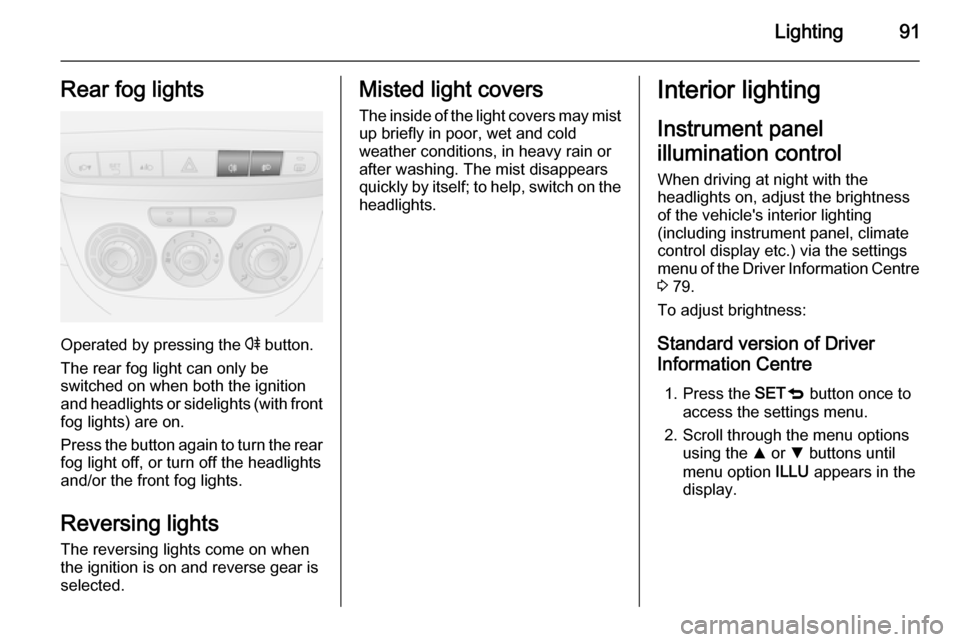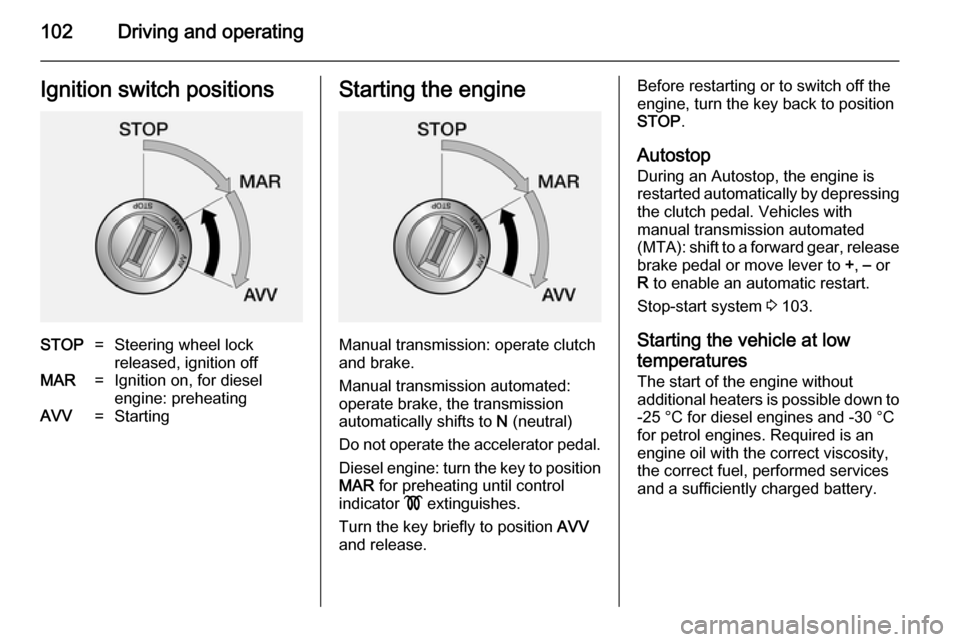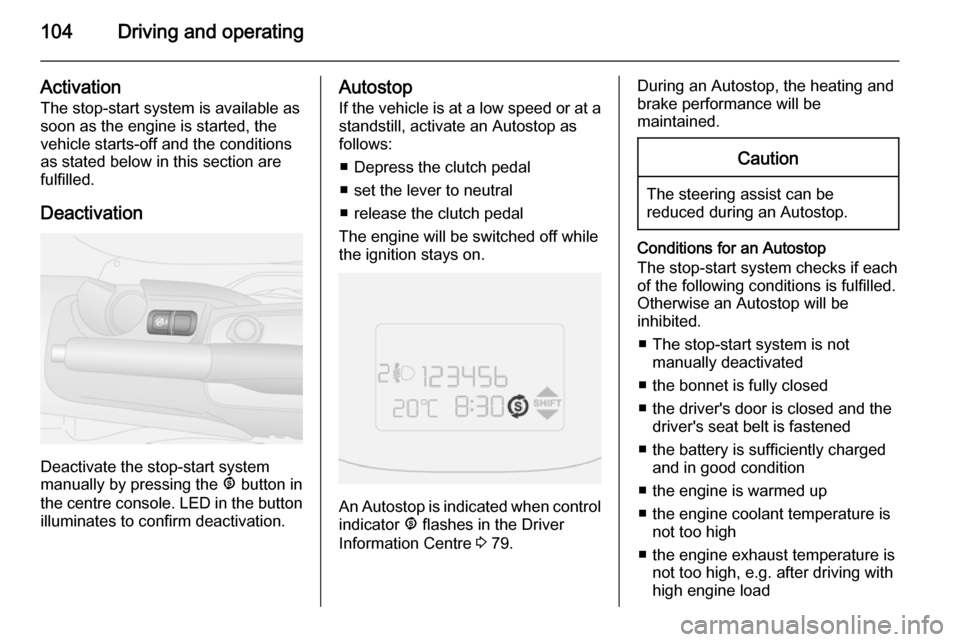ignition VAUXHALL COMBO 2014 Owner's Guide
[x] Cancel search | Manufacturer: VAUXHALL, Model Year: 2014, Model line: COMBO, Model: VAUXHALL COMBO 2014Pages: 187, PDF Size: 4.15 MB
Page 87 of 187

Instruments and controls85Vehicle messages
Warning chimes
Only one warning chime will sound at a time.
The warning chime regarding
unfastened seat belts has priority
over any other warning chime.
When starting the engine or
whilst driving ■ If seat belt is not fastened.
■ If a certain speed is exceeded with the parking brake applied.
■ If the parking assist detects an object.
■ If a fault is detected in the parking assist.
■ If a door or the tailgate is not fully closed when starting-off.
■ If the vehicle speed briefly exceeds
a set limit.
■ Vehicles with manual transmission automated; neutral is not selectedor the foot brake has not been
depressed.■ If a transmission fault is detected in
vehicles with manual transmission
automated.
■ If a warning message appears in the Driver Information Centre.
When the vehicle is parked
and/or the driver's door is
opened ■ When the key is in the ignition switch.
■ Vehicles with manual transmission automated; neutral is not selected,
the parking brake is not applied, or
the foot brake and/or the
accelerator pedal has not been
depressed.
Fuel system messages
Fuel cut-off system
In the event of a collision of a certain
severity, the fuel system is cut-off and
the engine is switched off
automatically, for safety reasons. A
corresponding warning message may also appear in the Driver Information
Centre 3 79.To reset the fuel cut-off system and
enable the vehicle to be driven, refer
to " Vehicle shutdown " 3 103.
Page 89 of 187

Instruments and controls87
The trip computer will reset
automatically when the maximum
value of any of the parameters is
exceeded.
Average consumption
Average consumption is displayed,
taking into consideration the distance
travelled and the fuel used since the
last reset.
The measurement can be restarted at any time.
Instantaneous consumption Display of the instantaneous fuel
consumption.
_ _ _ _ will appear in the display if the
vehicle is left parked with the engine
running for a long time.
Range
The range is calculated from the
current contents of the fuel tank and
the average consumption since the
last reset.
When the range is less than 30 miles ,
_ _ _ _ will appear in the display.After refuelling, the range is updated
automatically after a brief delay.
The measurement can be restarted at
any time.
Notice
The range will not be displayed if the
vehicle is left parked with the engine
running for a long time.
Distance travelled Displays the distance driven since the
last reset.
The measurement can be restarted at
any time.
Average speed
The average speed since the last
reset is displayed.
The measurement can be restarted at
any time.
Interruptions in the journey with the ignition off are not included in the
calculations.
Travel time (driving time) The time elapsed since the since thelast reset is displayed.The measurement can be restarted at
any time.
Exit trip computer
To exit the trip computer, press and
hold the SETq button for more than
2 seconds.
Driver Information Centre 3 79.
Interruption of power supply If the power supply has been
interrupted or if the battery voltage
has dropped too low, the values
stored in the trip computer will be lost.
Page 91 of 187

Lighting89Headlight range
adjustment
Manual headlight range
adjustment
To adapt headlight range to the
vehicle load to prevent dazzling of
other road users: Press À or Á
buttons until the required setting is displayed in the Driver Information
Centre 3 79.
0=Front seats occupied1=All seats occupied2=All seats occupied and load
compartment laden3=Driver's seat occupied and load
compartment laden
Headlights when driving
abroad
The asymmetrical headlight beam
extends visibility at the edge of the
road at the passenger side.
However, when driving in countries
where traffic drives on the opposite
side of the road, adjust the headlights
to prevent dazzling of oncoming
traffic.
Have the headlights adjusted by a
workshop.
Daytime running lights
Daytime running lights increase
visibility of the vehicle during daylight.
When the function is activated and
the ignition is switched on, the
headlights come on automatically and
instrument illumination is subdued.
The light switch must be in position
§ . The daytime running lights switch
off when the ignition is switched off.
Notice
The driver remains responsible for
switching on the low beam when
required, e.g. when driving through
a tunnel or at night.
When the function is deactivated, the
headlights do not come on
automatically when the ignition is
switched on and the light switch is in
position §.
The daytime running lights function is activated/deactivated via a menu in
the Driver Information Centre 3 79.
Page 93 of 187

Lighting91Rear fog lights
Operated by pressing the r button.
The rear fog light can only be
switched on when both the ignition
and headlights or sidelights (with front
fog lights) are on.
Press the button again to turn the rear fog light off, or turn off the headlights
and/or the front fog lights.
Reversing lights The reversing lights come on when
the ignition is on and reverse gear is
selected.
Misted light covers
The inside of the light covers may mist
up briefly in poor, wet and cold
weather conditions, in heavy rain or
after washing. The mist disappears
quickly by itself; to help, switch on the headlights.Interior lighting
Instrument panel
illumination control When driving at night with the
headlights on, adjust the brightness
of the vehicle's interior lighting
(including instrument panel, climate
control display etc.) via the settings
menu of the Driver Information Centre
3 79.
To adjust brightness:
Standard version of Driver
Information Centre
1. Press the SETq button once to
access the settings menu.
2. Scroll through the menu options using the R or S buttons until
menu option ILLU appears in the
display.
Page 104 of 187

102Driving and operatingIgnition switch positionsSTOP=Steering wheel lock
released, ignition offMAR=Ignition on, for diesel
engine: preheatingAVV=StartingStarting the engine
Manual transmission: operate clutch
and brake.
Manual transmission automated: operate brake, the transmission
automatically shifts to N (neutral)
Do not operate the accelerator pedal. Diesel engine: turn the key to positionMAR for preheating until control
indicator ! extinguishes.
Turn the key briefly to position AVV
and release.
Before restarting or to switch off the
engine, turn the key back to position
STOP .
Autostop
During an Autostop, the engine is
restarted automatically by depressing the clutch pedal. Vehicles with
manual transmission automated
(MTA): shift to a forward gear, release
brake pedal or move lever to +, – or
R to enable an automatic restart.
Stop-start system 3 103.
Starting the vehicle at low
temperatures The start of the engine without
additional heaters is possible down to
-25 °С for diesel engines and -30 °C
for petrol engines. Required is an
engine oil with the correct viscosity,
the correct fuel, performed services
and a sufficiently charged battery.
Page 105 of 187

Driving and operating103
Turbo engine warm-upUpon start-up, engine available
torque may be limited for a short time, especially when the engine
temperature is cold. The limitation is
to allow the lubrication system to fully
protect the engine.
Vehicle shutdown Fuel cut-off system
In the event of a collision of a certain
severity, the fuel system is cut-off and
the engine is switched off
automatically, for safety reasons. A
corresponding warning message may
also appear in the Driver Information
Centre 3 79.
Notice
In addition, the vehicle is
automatically unlocked and the
interior lights are illuminated.
Turn the ignition key to position
STOP to prevent battery discharge
and seek the assistance of a
workshop immediately. Have thevehicle checked for fuel leaks in the
engine compartment, beneath the
vehicle and near the fuel tank.
To reset the fuel cut-off system and
enable the vehicle to be driven:
1. Turn the ignition key to position MAR 3 102
2. Fully actuate the right turn signal light 3 90
3. Deactivate the right turn signal light
4. Fully actuate the left turn signal light
5. Deactivate the left turn signal light
6. Repeat steps 2, 3, 4 and 5.
7. Turn the ignition key to position STOP .9Danger
If you can smell fuel in the vehicle,
or a fuel leak is present, have thecause of this remedied
immediately by a workshop. Do
not reset the fuel cut-off system, to avoid the risk of fire.
Fuel system messages 3 85.
Overrun cut-off
The fuel supply is automatically cut-
off during overrun, i.e. when the
vehicle is driven with a gear engaged but accelerator is released.
Stop-start system The stop-start system helps to save
fuel and to reduce exhaust emissions.
When conditions allow, it switches off the engine as soon as the vehicle is
at a low speed or at a standstill, e.g.
at a traffic light or in a traffic jam. It
starts the engine automatically as
soon as the clutch is depressed.
A battery sensor ensures that an
Autostop is only performed if the
battery is sufficiently charged for a
restart.
Page 106 of 187

104Driving and operating
ActivationThe stop-start system is available as
soon as the engine is started, the
vehicle starts-off and the conditions
as stated below in this section are
fulfilled.
Deactivation
Deactivate the stop-start system
manually by pressing the ^ button in
the centre console. LED in the button
illuminates to confirm deactivation.
Autostop
If the vehicle is at a low speed or at a
standstill, activate an Autostop as
follows:
■ Depress the clutch pedal
■ set the lever to neutral
■ release the clutch pedal
The engine will be switched off while the ignition stays on.
An Autostop is indicated when control indicator ^ flashes in the Driver
Information Centre 3 79.
During an Autostop, the heating and
brake performance will be
maintained.Caution
The steering assist can be
reduced during an Autostop.
Conditions for an Autostop
The stop-start system checks if each
of the following conditions is fulfilled.
Otherwise an Autostop will be
inhibited.
■ The stop-start system is not manually deactivated
■ the bonnet is fully closed
■ the driver's door is closed and the driver's seat belt is fastened
■ the battery is sufficiently charged and in good condition
■ the engine is warmed up
■ the engine coolant temperature is not too high
■ the engine exhaust temperature is not too high, e.g. after driving with
high engine load
Page 107 of 187

Driving and operating105
■ the ambient temperature is not toolow
■ the climate control system allows an Autostop
■ the self-cleaning function of the diesel particle filter is not active
■ the vehicle has moved since the last Autostop
■ the brake vacuum is sufficient
■ the windscreen wipers are not operating at fast speed
■ reverse gear is not selected
■ heated rear window is not operating
Ambient temperature near to the
freezing point can inhibit an Autostop.
For manual transmission automated
vehicles, an Autostop may be
inhibited until a speed of approx.
6 mph is reached.
New vehicle running-in 3 101.
Battery discharge protection
To ensure reliable engine restarts, several battery discharge protection
features are implemented as part of
the stop-start system.Restart the engine
Manual transmission
The selector lever must be in neutral to enable an automatic restart.
Depress the clutch pedal to restart the
engine.
Manual transmission automated
If the lever is in position N, select
another gear, otherwise release the brake pedal or move the lever to +, –
or R to enable an automatic restart.
When one of the following conditions
occurs during an Autostop, the
engine will need to be restarted
manually using the key.
■ the driver's seat belt is unfastened and the driver's door is opened
■ three minutes have elapsed since the engine was switched off
If an electrical accessory, e.g. a
portable CD player, is connected to
the power outlet, a brief power drop
during the restart may be noticeable.Parking
■ Do not park the vehicle on an easily
ignitable surface. The high
temperature of the exhaust system
could ignite the surface.
■ Always apply parking brake. Apply manual parking brake without
pressing release button. Apply as
firmly as possible on downhill or uphill slopes. Depress the foot
brake at the same time to reduce
operating force.
■ Switch off the engine and ignition. Turn the steering wheel until the
steering wheel lock engages.
■ If the vehicle is on a level surface or
uphill slope, engage first gear. On
an uphill slope, turn the front
wheels away from the kerb.
If the vehicle is on a downhill slope, engage reverse gear. Turn the front
wheels towards the kerb.
■ Lock the vehicle.
Page 112 of 187

110Driving and operating
When the vehicle is parked and the
driver's door is opened, a warning
chime will sound if neutral is not
selected or the foot brake has not
been depressed.
Engine braking
Automatic mode
When driving downhill, the manual
transmission automated does not
shift into higher gears until a fairly
high engine speed has been reached. It shifts down in good time when
braking.
Manual mode
To utilise the engine braking effect,
select a lower gear in good time when driving downhill.Rocking the vehicle
Rocking the vehicle is only
permissible if the vehicle is stuck in
sand, mud, snow or a hole. Move the
selector lever between R and A/M (or
between + and -) in a repeat pattern,
while applying light pressure to the
accelerator pedal. Do not race the
engine and avoid sudden
acceleration.
Parking
Apply the parking brake. The most recently engaged gear (see
transmission display) remains
engaged. With N, no gear is engaged.
When the ignition is switched off, the transmission no longer responds to
movement of the selector lever.
If the ignition is not switched off, or the
parking brake has not been applied, a warning chime will sound upon
opening the driver's door.Manual mode
If engine speed is too low, the
transmission automatically shifts to a
lower gear.
In manual mode, no automatic
shifting to a higher gear takes place
at high engine revolutions. If engine
speed is too high, the transmission
only switches to a higher gear via
kickdown.
Kickdown 3 111.
Page 116 of 187

114Driving and operating9Warning
Do not let this special safety
feature tempt you into taking risks
when driving.
Adapt speed to the road
conditions.
Deactivation
ASR can be switched off when
spinning of drive wheels is required:
press button ASR OFF briefly.
LED in button illuminates and a
message appears in the Driver
Information Centre.
ASR is reactivated by pressing the
ASR OFF button again.
ASR is also reactivated the next time
the ignition is switched on.
Fault ASR will switch off automatically in
the event of a fault. Control indicator
x will illuminate in the instrument
cluster in conjunction with a message
in the Driver Information Centre 3 79.
Have the cause of the fault remedied
by a workshop.
Control indicator x 3 76.
Electronic stability
program
Electronic Stability Program (ESP)
improves driving stability when
necessary, regardless of the type of
road surface or tyre grip. It also
prevents the drive wheels from
spinning.
As soon as the vehicle starts to
swerve (understeer/oversteer),
engine output is reduced and the wheels are braked individually. Thisconsiderably improves the driving
stability of the vehicle on slippery road
surfaces.
ESP is operational as soon as control
indicator x extinguishes.
When ESP comes into action, control indicator x flashes.
The ESP system is automatically
activated when the vehicle is started
and cannot be deactivated9 Warning
Do not let this special safety
feature tempt you into taking risks
when driving.
Adapt speed to the road
conditions.
Fault
In the event of a fault, ESP will be
automatically switched off and control
indicator x will illuminate in the
instrument cluster in conjunction with
a message in the Driver Information
Centre 3 79. The LED in the ASR
OFF button will also illuminate.